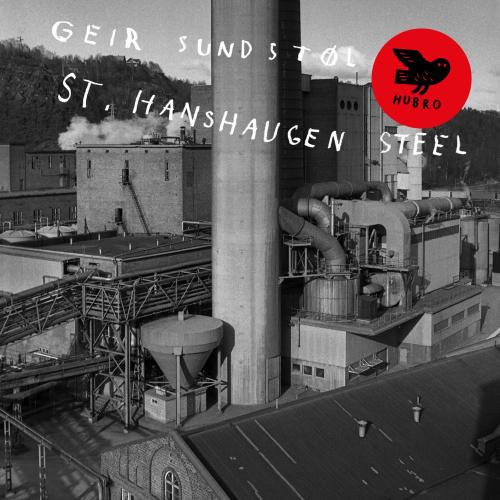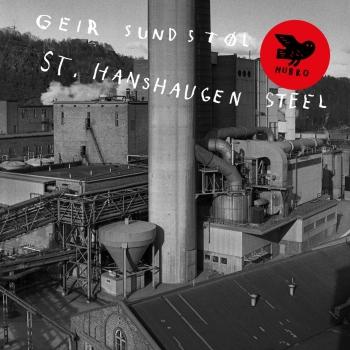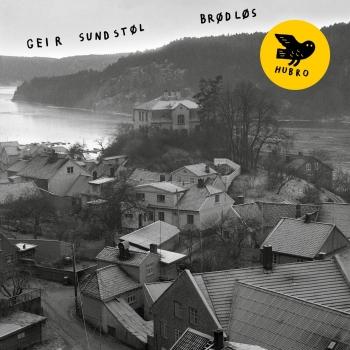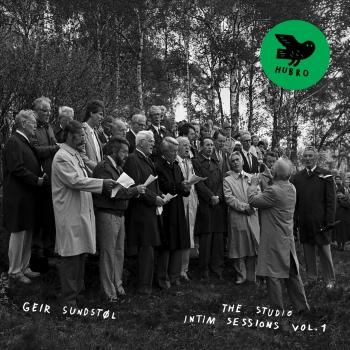
St.Hanshaugen Steel Geir Sundstøl
Album info
Album-Release:
2021
HRA-Release:
01.10.2021
Album including Album cover
- 1 Våg 05:11
- 2 Lyssky 04:05
- 3 Ka 05:25
- 4 Kløpper 03:49
- 5 Hoven 04:22
- 6 Smet 04:02
- 7 Omsorg 03:19
- 8 Pøs 04:07
Info for St.Hanshaugen Steel
After appearing on more than 400 albums as a sideman and session player, multifaceted guitarist and instrument collector Geir Sundstøl gave us a trilogy of his, long awaited, own compositions. Now he is back, with a follow-up to Norwegian Grammy-/Spellemannpris- winning album Brødløs.
St.Hanshaugen Steel offers an extraordinarily wide range of genre references, and takes us further into Sundstøl’s original and distinctive soundscapes. With clear cinematic features, Sundstøl displays an ever impressing variety of instruments, sliding from the deep and rough bass harmonica to the sharp, circus-like marxophone. In between, multiple layers of glimmering steel. Guest appearances by he angelic Sølvguttene boys’ choir bring utter goose bumps, while other parts of St.Hanshaugen Steel might induce the darker chills of Nordic Noir.
The album St.Hanshaugen Steel is an homage to the factory bearing the same name. The steel factory, founded by the somewhat evasive Jebsen Brothers, was in operation between 1890 and 1969, and was located on St.Hanshaugen in Oslo, which now is a highly popular residential area, and Sundstøl’s own stomping ground.
But rather than the chimes of industry, St.Hanshaugen Steel pays attention to the nuts and bolts that give rise to the whole machine. The title may, of course, also be a reference to Geir Sundstøl’s reputable broad spectrum-treatment of the pedal steel guitar.
While the sound of St.Hanshaugen Steel shares points of continuity with earlier Sundstøl Hubro releases Furulund (2015), Langen Ro (2016) and Brødløs (2018), there are some important departures. A new palette of sound-making devices, from Sundstøl’s hording of synthesizers, has made its quite audible mark.
«Being born in the late sixties, vocoders, Simmons synth drums, and synths in general, sound very modern to me.» Hours of exploration and studies of this “modernity” shine through this otherwise organic music, as does the analog modification of familiar sounds: «Initially, it startet out as a technical project. I wanted to explore the possibilities of recording pedal steel onto analog tape, at 30 ips, and then slowing it down to 15 ips. Exactly an octave below. There are still traces of that experiment on the album (tracks Smet and Våg), but the exploration turned into songs.»
Another experiment developed into the eclectic track Hoven: «I fiddled with the pitch controller on my raga box. It slowly evolved into a strange melody. It was still a Hindu melody, but when we added the church-like bass lines and the boys’ choir, it morphed into a multi-religious song.»
Like his first and third album (the sec0ond was recorded at St.Jakob church in Oslo), Sundstøl made the St.Hanshaugen Steel at home, in his Studio Intim. Once again calling upon some of his favourite musical brothers in arms; drummer and percussionist Erland Dahlen, bass players Mats Eilertsen and Jo Berger Myhre, and pianist/keyboardist David Wallumrød.
Although Sundstøl himself handles a vast variety of sometimes “unusual” instruments - he is indeed a collector as well as a composer and musician - the presence of these “usual suspects” is crucial to achieve the Sundstøl musical universe. Erland Dahlen is also often by Sundstøl’s side at live performances. A Duo Extraordinaire.
A unique voice, yet new to this particular universe, is Arve Henriksen, who leaves his personal mark on the opening track, Våg. «I had admired Arve’s lyrical expression for years, and finally I mustered up the confidence to ask him to participate.» Initially, the trumpeter was asked to play on the outro of Våg, but he «got carried away, and added 10 tracks of trumpet and horn. We recorded Våg, thinking half-speed pedal steel, upright bass and 80’s Simmons Drums would be the core of the song. It came out a little more than that.”
Sundstøl describes the further tracks on St.Hanshaugen Steel: “Lyssky” draws inspiration from spooky British sci-fi as well as pompous, white wig-wearing composers. David takes us on a trembling journey with his Arp synth.
KA is Indian Shankar- and National guitar-Blues. Handheld bells, analogue synths and Norway’s most beloved traditional boys’ choir, Sølvguttene. The thought of their singing in my living room still fills me with awe.
Kløpper: Mats (Eilertsen) sent me a bass line, without any instruction. I found it especially tricky to add the Mini Pops drum machine. Certainly a backwards way of doing things, but valuable. The melodica solo is an homage to the late Augustus Pablo. Pedal steel and National guitar on a bed of dub beats. My Bermuda Triangle.
Hoven: It’s got ethereal organ, Christian church-like bass over a twisted Hindu beat. I play the usual National- and pedal steel guitar, and to top it off, we added the Sølvguttene boys’ choir,. A ‘multi-culti’ song if there ever was one, with a spiritual twist.
Smet: This is quite an eerie mix of cold DX7 synth, electric insects running around Erland’s snare drum, upright bass and Parisian toy pianos. It bears traces of the mentioned technical experiment; recording steel at high speed and then slowing it down.
Omsorg: I don’t write music - I play, make mistakes that sound good, and then try to create something out of that. This track has guitar-o-phone, optigan, steel, national guitar, organ and an upright bass that sounds like an old motor boat. The bass function lies in the harmonica. And the title translates to “care”.
Pøs: 80’s vocoder and Shankar guitar paired with the Wurlitzer Side Man, the world’s first drum machine. This is probably the only track that bears any resemblance to industrial sounds. It has a somewhat old fashioned melody line, like something the great Cornelis Vreeswijk would have sung about a dad working at the factory.
For me, melody is the key. If there’s no melody, or if the melody doesn’t add up, I don’t get it.»
Geir Sundstøl, pedal steel, National duolian, Shankar guitar, six string bass, Yamaha CS-20, optigan, harmonica, bass harmonica, cümbüs, guitar banjo, mandolin, Prime Time loops, Yamaha DX7, Logan String Melody, melodica, tabla and drum machines, Michelsonne toy piano, marxophone, guitarophone, Simmons SDS8, concert harp, Juno 6, cither, and Roland SVC 350 vocoder
Erland Dahlen, drums, drum machine, steel drum, log drum, marching toms, xylophone, dulcimer, musical saw, Schulmerich handbells, waterphone, electric insects, blossom bells and triangle
David Wallumrød, Minimoog, Prophet 5, Arp Pro Soloist, Hohner clavinet and Juno 6
Mats Eilertsen, acoustic bass and organ
Jo Berger Myhre, acoustic and electric bass
Arve Henriksen, trumpet and vocals
Sølvguttene
Geir Sundstøl
Guitarist and instrument collector Geir Sundstøl appeared on over 260 albums as a session player and sideman before he released his solo debut “Furulund” in 2015. After 27 years as a professional musician he finally took the big step, and was rewarded with glowing reviews and a Norwegian Grammy (Spellemannspris) nomination.
Mojo described Sundstøl’s debut album as “a soothing series of languid guitar soundscapes that blend Cooderesque western warmth with a twilight Norwegian chill.” The British magazine HiFi+ highlighted “the great choice of sounds” and the Norwegian music writer Terje Mosnes referred to the “musicianship that doesn’t shout, but that wins the listener over through the subtle tonal diversity that gradually emerges, making each listen a new experience.”
Now, three years later, with the acclaimed «Langen Ro» (2016) under his belt, Sundstøl is following up his success with a new album, Brødløs.
Ambient goes country and David Bowie and Brian Eno share a tune with John Coltrane in slide guitar maestro Geir Sundstol’s astonishing cinematic travelogue. Tumbleweed blows across the widescreen desert vistas of a curiously Nordic western landscape; the melancholy-sounding scrape of a metal slide on bare steel wire is set to the same, slow, clip-clopping equestrian rhythms we hear in horse-drawn cultures from Texas to Outer Mongolia; what seem at first to be familiar musical textures drawn from ambient music, country rock or jazz are made strange through their juxtaposition with oddly clashing elements taken from totally different registers: Indian tabla drums with Mini-Moog, say, or the gated thwack and hiss of Eighties power-ballad drums next to an avant-garde electronic shimmer or Sneaky Pete-style pedal steel. It’s a fascinating place where ‘Paris, Texas’ might meet ‘Tubular Bells’, Ennio Morricone can rub shoulders with Brian Eno, and David Bowie really does run into John Coltrane. This is ‘Brødløs’, the third solo album by the Norwegian composer, guitarist and multi-instrumentalist Geir Sundstøl.
This album contains no booklet.











